|
|
|
Sort Order |
|
|
|
Items / Page
|
|
|
|
|
|
|
| Srl | Item |
| 1 |
ID:
148843


|
|
|
|
|
| Summary/Abstract |
On January 23rd this writer was invited to speak at the All India Bank
Employees Association (AIBEA) annual meeting, led by the Punjab
National Bank, on The Future of Democracy in India. The theme seemed
a little incongruous for an occasion where, “Comrades of the World
Unite,” to discuss their welfare. In fact, I wonder if bankers ever have
the time to think or worry about democracy. Judging by the mechanical
manner in which the customers who enter the banks are greeted it
would seem that democracy is an outlandish concept.
|
|
|
|
|
|
|
|
|
|
|
|
|
|
|
|
| 2 |
ID:
158293
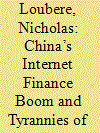

|
|
|
|
|
| Summary/Abstract |
One of the main drivers of China’s e-commerce boom is the dramatic expansion of the country’s Internet finance industry, which has grown and diversified at a staggering rate over the past decade. The emergence of Chinese Internet finance has been discussed in largely positive terms as facilitating commercial activity. It has also been linked to the wider developmental goal of promoting financial inclusion through the provision of financial services to previously excluded populations. Emerging from the global microfinance movement, the concept of financial inclusion depicts increased access to financial services (particularly credit) as an inherently beneficial means of empowering the poor and driving bottom-up economic development. This article challenges this dominant narrative of beneficial digital financial inclusion in China. It draws on the growing body of literature critiquing the global financial inclusion movement, and examines examples of exploitation, fraud, instability, and extraction related to expanded digital financial coverage in contemporary China. It then demonstrates that digital financial inclusion is part and parcel of the Chinese government’s plans to create a social credit system in an attempt to construct a “trustworthy society.” In this way, digital financial inclusion can be seen as a key element in a wider project of expanding surveillance through big data in order to close down spaces for those seeking to contest the hegemonic socioeconomic order. The article argues that these examples illuminate fundamental processes implicit in the expansion of the commercial Internet finance industry. In this way, while the extension of digital financial inclusion in China benefits certain groups, it also necessarily serves to reproduce patterns of inequality and exploitation.
|
|
|
|
|
|
|
|
|
|
|
|
|
|
|
|
| 3 |
ID:
167051


|
|
|
|
|
| Summary/Abstract |
The importance of an inclusive financial system in the overall growth and economic development of a nation is well recognized. While most studies on financial inclusion use supply-side data, this article presents a demand-side analysis of factors associated with financial inclusion. Making use of a large cross-country data on financial inclusion status and individual characteristics of adult individuals, we econometrically establish that individual characteristics and economic circumstances play very significant role in determining financial inclusion of adult individuals, after taking into account other factors of the country. The article uses three indicators of financial inclusion and several explanatory variables such as country-specific factor (gross domestic product [GDP] per capita), individual characteristics and individual economic circumstances of adult individuals from different countries. We find that in general, being woman, less educated, jobless and poor are negatively associated with financial inclusion of individuals. Enhanced level of education and income, in general, enhances likelihood of financial inclusion. These findings should be taken into account while formulating policies towards promotion of financial inclusion.
|
|
|
|
|
|
|
|
|
|
|
|
|
|
|
|
| 4 |
ID:
178428


|
|
|
|
|
| Summary/Abstract |
This article examines the nexus between financial inclusion index and economic growth in all eight South Asian Association for Regional Cooperation (SAARC) countries, using annual data from 2004 to 2017. In order to determine the possible long-run relationship between these variables, the study adopted the Pedroni panel co-integration test and two types of co-integration regression methods, the Fully Modified Ordinary Least Square (FMOLS) and the Dynamic Ordinary Least Square (DOLS) methods. The Pedroni panel co-integration test confirms the existence of a long-run relationship between financial inclusion and economic growth in the SAARC countries. The coefficients of FMOLS and DOLS indicate that the index of financial inclusion and selected control variables together support economic growth. In addition, the Granger causality test confirmed bi-directional causality between FI and economic growth.
|
|
|
|
|
|
|
|
|
|
|
|
|
|
|
|
| 5 |
ID:
163339


|
|
|
|
|
| Summary/Abstract |
Using the Chinese Household Finance Survey data set, the study shows that concern with relative income significantly stimulates poor households to apply for bank credit. The effect of income comparisons on credit applications can be explained by either a “keeping up with the Joneses” effect, in which the poor seek financing for costly consumption to emulate the wealthy's consumption style and thus suffer persistent poverty, or else a “tunnel” effect, in which the poor are inspired by the wealthy's economic success and enlightened to use credit for investment. Although this study provides no empirical evidence of a “keeping up” effect, it reveals that credit applicants invest significantly more in human capital than non-applicants, and it demonstrates that the “tunnel” effect is the primary incentive for relatively poor households to participate in the credit market. Poor households are capable of using finance to escape from poverty.
|
|
|
|
|
|
|
|
|
|
|
|
|
|
|
|
| 6 |
ID:
175349
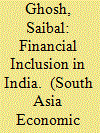

|
|
|
|
|
| Summary/Abstract |
Employing a novel district-level survey data for India, the study investigates the impact of distance on financial inclusion. Using advanced econometric techniques, the findings indicate that distance primarily dampens the use of bank accounts as compared with access. These results are robust irrespective of whether distance is measured in terms of the time taken to reach the banking infrastructure or physical distance. These results are robust to a wide battery of robustness checks. The analysis suggests the need for policy strategies that can address the tyranny of distance towards achieving the financial inclusion goal.
|
|
|
|
|
|
|
|
|
|
|
|
|
|
|
|
| 7 |
ID:
161099
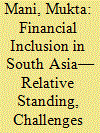

|
|
|
|
|
| Summary/Abstract |
Financial Inclusion is eminent for sustained growth in South Asia. This study is
an attempt to measure and comparatively analyze the levels of financial inclusion
in South Asian countries. On the basis of eighty-nine parameters, it is found that
the situation of financial inclusion in South Asia is modest as compared to other
regions of the world. The usage of banking services, use of debit and credit cards,
bank-borrowing, deposit of savings is at low levels. The use of e-banking is also
extremely low; however, the mobile-banking is picking up. The gender bias is high
in most of the countries as there are more male users as compared to female
users. Many initiatives are being taken to promote financial inclusion and the
situation has also improved data-wise, but there is still is a long way to go. This study
is distinguished in providing a comparative picture of South Asian countries.
|
|
|
|
|
|
|
|
|
|
|
|
|
|
|
|
| 8 |
ID:
187032
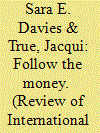

|
|
|
|
|
| Summary/Abstract |
The Women, Peace and Security (WPS) agenda and women's participation in peace processes are strongly supported by states. Yet financing to support the implementation of WPS has lagged behind overt international commitments to the agenda. WPS scholars and practitioners have highlighted the funding shortfalls for enabling WPS implementation and continued under-investment in gender-inclusive peace. In this article, we ask how much are donor states financially backing the implementation of gender-inclusive peace agreements which they promote? We use a high ambiguity-conflict model of policy implementation to explore the mechanisms of bilateral and multilateral financing for gender-inclusive peace. We trace to what extent international investments are supporting specific gender provisions in two progressive gender-inclusive peace processes, the 2016 Colombian Peace Agreement and 2015 Comprehensive Peace Agreement in the Philippines. In both case studies, we reveal a drastic gap between the international donor rhetoric and the funding. Patterns of financial investment do not follow nor support the life cycle of inclusive peace processes. We suggest key strategies for further research to address this policy and recommend that all gender provisions of peace agreements be monitored in-country and all gender-responsive investments be tracked and evaluated.
|
|
|
|
|
|
|
|
|
|
|
|
|
|
|
|
| 9 |
ID:
155206


|
|
|
|
|
| Summary/Abstract |
India undertook a monetary experiment of gigantic scale on November 8, 2016, that resulted in the withdrawal of the legal-tender character of Rs. 500 and Rs. 1000 currency. We make a preliminary attempt to analyze existing data to understand the various dimensions of the great monetary gamble.
|
|
|
|
|
|
|
|
|
|
|
|
|
|
|
|
| 10 |
ID:
165086
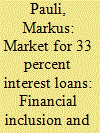

|
|
|
|
|
| Summary/Abstract |
Financial inclusion is the process of building viable institutions that provide financial services to those hitherto excluded. These may include savings, insurances, remittances, and credit. Microfinance became the most dominant method for achieving financial inclusion. However, different microfinance schools of thought recommend opposite ways for attaining financial integration. India is a particularly insightful case study due to the sheer number of people excluded from formal financial services, as well as the spectrum of actors and approaches. The aim of this article is threefold. The first aim is to define financial inclusion, depicting its status quo in India and comparing it to its South Asian and Brazil, Russia, India, China, and South Africa (BRICS) peers using recently released data from the Global Findex database. The second aim is to focus on microfinance as the dominant vehicle for achieving financial inclusion by scrutinizing its definitions, contrasting its two leading “schools of thought,” and analyzing the central role of its dominant group-based approach. The third aim of the article will examine why people opt to take micro-credit at 33 percent interest rates.
|
|
|
|
|
|
|
|
|
|
|
|
|
|
|
|
| 11 |
ID:
171895
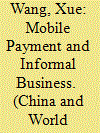

|
|
|
|
|
| Summary/Abstract |
This paper uses household panel data to explore the impact of mobile payments on China's household business activity. Using a difference‐in‐difference fixed effect specification, I find that mobile payment users are more likely to operate small‐scale and self‐employed informal businesses. The impact of using mobile payment primarily derives from the transition of agricultural families to business owners and the development of informal businesses. The paper illustrates an associated increase in employment and income for family members, with more pronounced effects on low‐income and rural households. It also provides prima facie evidence of the increase in fund transfers, which is important for risk sharing that informal businesses may encounter.
|
|
|
|
|
|
|
|
|
|
|
|
|
|
|
|
| 12 |
ID:
186875
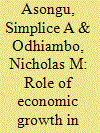

|
|
|
|
|
| Summary/Abstract |
This study establishes economic growth needed for supply-side mobile money drivers in developing countries to be positively related to mobile money innovations in the perspectives of mobile money accounts, the mobile phone used to send money, and the mobile phone used to receive money. The empirical evidence is based on Tobit regressions. For the negative net relationships that are computed, minimum economic growth thresholds are established above which the net negative relationships become net positive relationships. The following minimum economic growth rates are required for nexuses between supply-side mobile money drivers and mobile money innovations to be positive: (i) 6.109 percent (6.193%) of Gross Domestic Product (GDP) growth for mobile connectivity performance to be positively associated with the mobile phone used to send (receive) money and (ii) 4.590 percent (4.259%) of GDP growth for mobile connectivity coverage to be positively associated with the mobile phone used to send (receive) money.
|
|
|
|
|
|
|
|
|
|
|
|
|
|
|
|
| 13 |
ID:
131246


|
|
|
|
|
| Publication |
2014.
|
| Summary/Abstract |
The Self-Help Group-Bank Linkage Programme (SHG-BLP) was designed with the objective of bridging the prevailing gap in the financial network and spreading banking facilities to the poor in rural and urban areas. This paper examines the progress of SHG-BLP over the last two decades in terms of: (a) the outreach of SHG-BLP; (b) spatial disparity in SHG-BLP; (c) SHG spread with respect to banking and socio-economic indicators; and (d) potential vis-à-vis achievement under the programme in terms of coverage of rural poor population.
|
|
|
|
|
|
|
|
|
|
|
|
|
|
|
|
| 14 |
ID:
143419
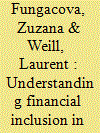

|
|
|
|
|
| Summary/Abstract |
We use data from the World Bank Global Findex database for 2011 to analyze financial inclusion in China, including comparisons with the other BRICS countries. We find a high level of financial inclusion in China manifested by greater use of formal account and formal savings than in the other BRICS. Financial exclusion, i.e., not having a formal account, is mainly voluntary. The use of formal credit is however less frequent in China than in the other BRICS. Borrowing through family or friends is the most common way of obtaining credit in all the BRICS countries, but other channels for borrowing are not very commonly used by individuals in China. We find that higher income, better education, being a man, and being older are associated with greater use of formal accounts and formal credit in China. Income and education influence the use of alternative sources of borrowing. Overall financial inclusion does not constitute a major problem in China, but such limited use of formal credit can create a challenge for further economic development.
|
|
|
|
|
|
|
|
|
|
|
|
|
|
|
|
|
|
|
|
|